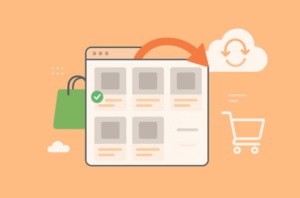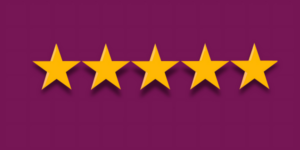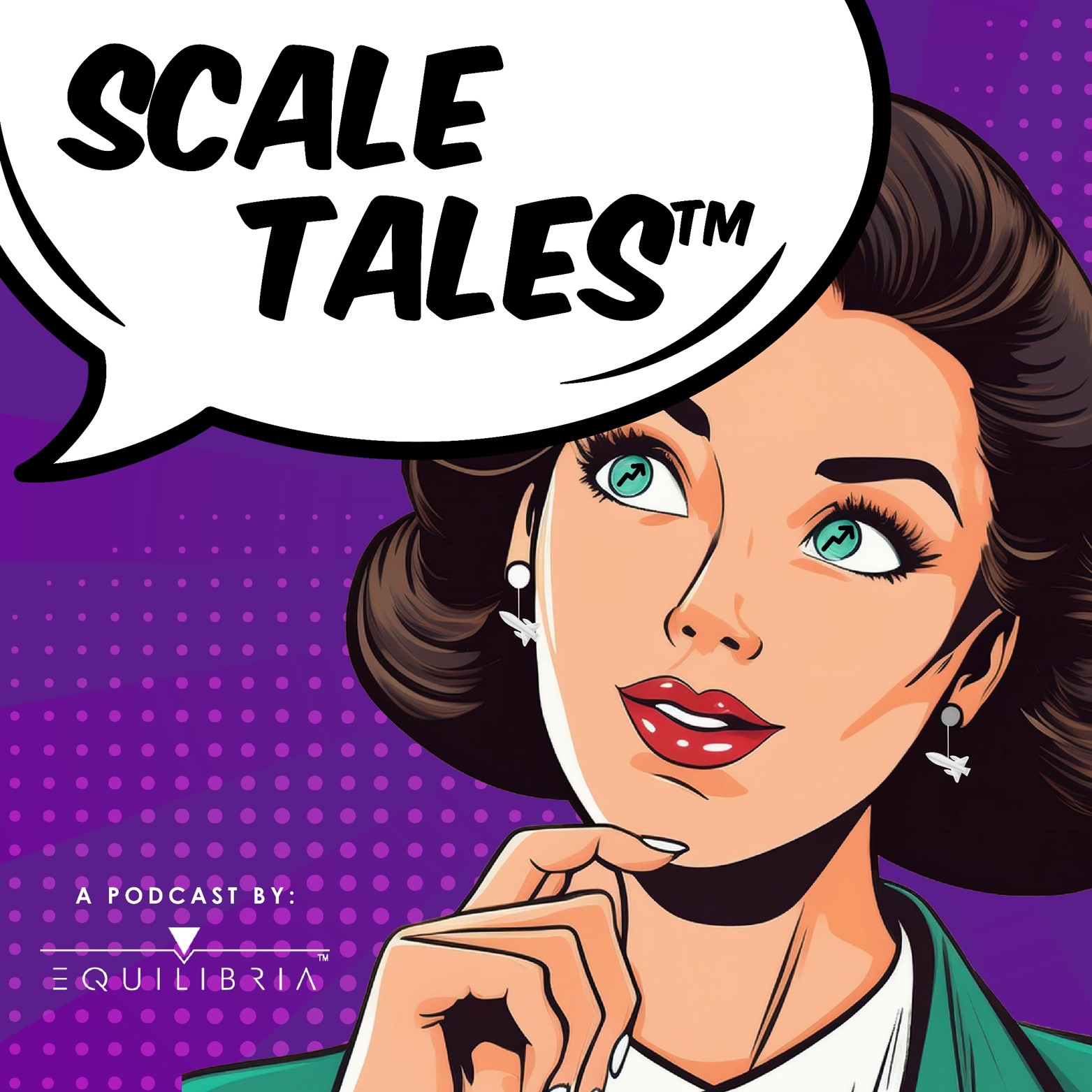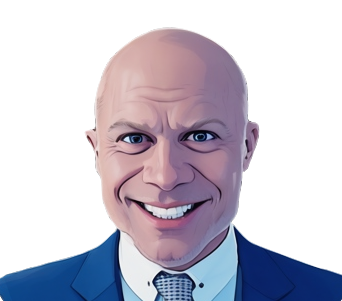Transcript
This podcast is brought to you by Equilibria, Inc. Did you know you can earn PDUs from listening to this show? It’s easy, accessible, and submitted directly to PMI. Keep listening to learn more.
Equilibria provides training to assist fast-growing companies to increase capacity and cash flow while operating at maximum performance. As a founder, leader, or project manager you know all too well that chaotic work environments aren’t sustainable. Visit EQBsystems.com to sign up for a free discovery call and start flowing today! EQBsystems.com.

Welcome to Scale Tales – the business storytelling podcast where entrepreneurs, executives and experts share firsthand accounts of those magical moments when they achieved something bigger than even they could have imagined.
I’m Alicia Butler Pierre. In a world of get rich quick schemes and inboxes filled with emails promising fast customer acquisition, it can be tempting to get caught up and make impulsive decisions. But, as the saying goes, “Good things come to those who wait.” And that holds true for many online or digital marketing strategies. Though we may have carefully crafted and organized project plans to deploy those strategies, it can be easy to get discouraged when things don’t take off right away.
But there can be legitimate ways to shortcut the path to more customers. You just have
to know certain tips and techniques.
This is Ep. 38: How Brandon Liebowitz Used SEO to Grow a Client’s Online Presence by 300% in One Year.
Hello, I’m Brandon Leibowitz, owner of SEO Optimizers. I’m currently in Venice, California and this is my scale tale.
It started in 2015 when I helped a client in the e-commerce space grow their presence by 300% by helping them optimize their website and get more visibility on Google searches by utilizing what is called search engine optimization or SEO, ranking websites on different search engines, which is primarily Google. When you search on Google there are ads at the top. Those are all paid ads. Right below the ads are the free listings, the organic listings.

I was helping out this company, they sold rugs online as an e-commerce website. Instead of just listing their website on Google, I also optimized their products by getting them on Google Shopping. When you search on Google, products sometimes appear and that just doubles the chances of somebody finding them and clicking and buying or
going to their website to look at their products, also optimizing their images on their website. They had some YouTube videos which also appear on Google and really is just trying to take as much free real estate as possible on that first page of Google without spending money on paid ads. They weren’t a local business. They were strictly ecommerce, no storefront. They just wanted to get more traffic to their website.
And that entailed going in and looking at their competitors and trying to figure out what this rug company is doing versus their competition and what’s working for the competitors that’s not being implemented by this rug company. How can we fix that gap and get them to that level that their competitors are at? That starts by looking at their competitors’ websites to look at what keywords they rank for, how they structure their website, what type of pages they build out. Because if you’re just selling rugs, you don’t want to just rank for rugs.
That’s going to get you a lot of traffic, but a lot of people that are just not looking to buy rugs. We want buyer intent keywords that have intent behind it to make a purchase. Someone searching for rugs for my kitchen or bathroom rugs or bathroom jute rugs or cecil rugs for living room. These more long-tail keywords have more buyer intent that results in not just getting you traffic, but traffic that’s probably going to want to buy your product or service.

We realized we need to create pages for all the different home or rooms in a home that you would want to buy a rug for. Because someone’s searching for a bathroom rug, doesn’t care about a kitchen rug, and they don’t care about an outdoor rug. Even though they’re very similar, it’s different intent. So we looked at the competition, saw how they built out their websites and structured it in a similar way by building out pages that target the different rooms in the home. Also, the different colors of rugs, the different styles, the different shapes. Because someone searching for a square rug doesn’t want to see a circle rug and vice versa.
And having these pages that are dedicated to those keywords makes you relevant to somebody searching for that on Google. Doesn’t get you to rank because Google doesn’t believe anything anybody puts on a website. You have to build trust. And trust to Google comes through third party sites that talk about you. The more websites that mention your website, the more trust Google is going to give to you. And then they look at those keywords on your website. But it doesn’t work the other way around. If you’re not building what are called backlinks, Google’s not going to trust you and they’re not going to rank a website that they don’t trust.
So with the rug company putting keywords, building these pages out, adding new content to their website, adding blog posts is all great, but we need to get third party sites mentioning them. Finding other websites that are niche related and seeing if we could start writing for them and get editorial status at other websites. Giving products away to websites or influencers that have blogs that write about it, because then they share it on their website, Google sees that another website is mentioning the rug company. That builds that trust. It’s like a popularity contest. The more websites that
mention you, the more popular Google’s going to think you are and the higher they’re going to rank you.
After building backlinks for a few months that got Google to start trusting them. And they went from being not even on the first 10 pages of Google to page one or page two depending on the keywords, after building a few more backlinks and keeping it consistent, And from there they just kept going up and up. So backlinks in conjunction with keywords built that trust with Google and showed what keywords that align with that buyer intent. And that resulted in more traffic.
Imagine – there’s a rug company with a great product, but because they don’t have a physical location, they must rely heavily on their website to attract potential customers. They clearly understood that getting ranked higher on Google would increase their chances of their website and products being found. However, as Brandon warns, getting potential customers to click on a website is one thing, getting them to buy is another.
Traffic doesn’t mean more sales so we also had to look at their website from a conversion rate perspective. How do we make sure that every visitor doesn’t just visit this website, but actually converts. We have to look at the whole buying to checkout process. Make sure it’s easy to do on desktop, but also on mobile. Make sure everything loads quickly, make sure all the images look good of the products. That way it pops out. Making sure that you have all your important information above the fold.
When you look at a screen on a website, whatever you see on that screen is called above the fold. Once you start scrolling, that’s below the fold, most people will not scroll down. So you want to have all your pertinent information at the top of the page, like your title of the product, your images right there. Maybe some bullet points and a call to action. Pretty much mimicking what Amazon does because they’ve A/B tested that website, spending tens of millions of dollars trying to perfect it to make it optimized as much as possible for conversions.
In case you’re wondering what A/B testing is, it’s when you try different messaging or layouts on two websites or webpages to determine which does a better job at attracting more visitors. Amazon has the budget for A/B testing, but likely you don’t. Or maybe you do. Either way, Brandon says there are some simple, low-cost things you can do to conduct your own A/B testing on your company’s website.
Maybe you change your shopping cart button from “add now” to “add to cart” and you see if that increases conversions or you change the color from dark blue to light blue and you see how that affects conversions because all those little changes will have an impact on how many people actually buy your product.
And the months of testing and trial and error paid off. Not only did Brandon help the rug company’s website to show up on the first page of Google Search results for specific keywords, but his SEO strategy also helped the company increase the traffic to the site and actually convert visitors into customers.
They were getting about 2% conversion rate before I joined. After working with them and optimizing their website, we got them up to 5% conversion rate. And that’s also something that a lot of people overlook when they’re doing online marketing. SEO is how to make sure their website is optimized for those conversions. That way they’re not just getting traffic, but they’re actually getting sales and leads and phone calls or whatever that conversion goal is. Because traffic is great, but it’s not really a means to an end.
If you’re wondering how this rug company found Brandon, well, it had to do with his own company’s SEO strategy.
They found me through my SEO agency, SEO Optimizers. I have my website and I’ve optimized it over the years to start ranking for keywords related to SEO and digital marketing. And they searched, they were in Los Angeles. I’m in Venice, but I’m in Los Angeles technically so they found me there and they reached out, which is the best when you could start getting inbound leads.
When I first started doing SEO, I would do cold outreach and that never really works too well it’s very tedious and people don’t like cold outreach. So, I try to stay far, far awayand get those inbound leads, which SEO is great at doing that.
Inbound leads are those that come as a result of you offering valuable content that is relevant to these potential customers. This content positions you, the author or provider of the content, as a trusted thought leader. Content can include things like videos, white papers, blog posts, and LinkedIn newsletters. When it comes to deploying an inbound lead strategy, Brandon says it’s like a
puzzle.

You want to put all those pieces together with SEO, and some pieces are bigger than others. Those backlinks are a big piece of it. So I’m always building backlinks while I’m working on the other tasks to help out. The faster you can build backlinks, the faster you’re gonna get Google to trust you. And that means faster rankings.
Faster rankings that can lead to results like increasing organic traffic to a rug company’s website by 300% in less than a year. That’s what Brandon managed to do for his client. With that kind of result I wondered how long did it take after he began optimizing their website and all of their rug images to work on the actual SEO campaign.
We started working on it right away and about three months into it, they started to get that big push because SEO is not immediate. It takes time for Google to trust and rank a website. It’s more of a long-term play. So you have to build that trust. And trust takes time with those backlinks. Usually, if you have an older website, then it moves up quicker. But if you’re a brand-new website, it’s going to take six months on average to get Google to trust you.
Now that we know how Brandon used SEO to scale website traffic flow and ultimately customers to his rug company client, let’s go further back in time. 2007 to be exact. That’s the year Brandon first started helping business owners with SEO. So how did that lead to him starting his own company, SEO Optimizers?
I started back in 2007 helping people get more of that traffic from Google after I graduated from college and got my degree in business marketing. One of the first jobs is helping the company out with their digital marketing, which I didn’t really know much about it. They don’t really teach you that in school back in 2007. I told the company that and they said,
“Don’t worry, we’re new to this as well we’re gonna learn with you and take you to classes and workshops and seminars”
Did that for a few months after going to a few different workshops and realized I could work full time at this company. I could also go to a restaurant and be like,”Hey, do you need some help with SEO?”
Because the company I was working for, they made a very, very niche product. They only had like five competitors globally. So I don’t really have to worry about stepping on any toes by having competitive websites. So I was able to go to just local businesses and kept building it up over the years.
To be clear, because the company Brandon began working for outside of University had such a niche product, he was able to comfortably start his own company as a side hustle. He could freely work with other businesses without the fear of potentially encroaching on the company where he was employed. It was during this time that he eventually met the owners at the rug company.
So in 2007 I got my first job out of school helping a company out with their digital marketing. A few months into it, I realized that I could do my own thing as well and work full time at this company and also pick up a few freelance clients here, there and make some extra money. Did that for a while, working at different advertising agencies as a director of SEO before work, after work on my lunch breaks, working on my own company.
Eventually built that up to where I was able to quit my job. At the beginning I was just happy to have a full-time job after college and make a little bit of extra money on the side doing some freelance gigs. Built that company up and just kept going with it over the years. Probably in 2017 I decided to really go all in and quit my job and just focus all on my company.
And that focus led to what has become an amazing entrepreneurial journey for Brandon. Coming up after the break, we’re going to dive deeper into howBrandon has mastered the art of delegation. He’ll reveal some key strategies for finding the right people to help grow your organization and share what it truly takes to build a team that supports scaling. Plus, you’ll learn about his free special offer to teach you some of his proven SEO techniques.
Are you a certified Project Management Professional? Just imagine, you can literally listen and learn while you earn credits. Yes, even while you’re taking a long walk, driving to or from work, even while you’re on an airplane. The good thing about our podcast episodes is that you don’t have to watch them in order to earn your PDUs.
In three easy steps – Visit ScaleTalesPodcast.com, sign up for a membership, take a short quiz and we’ll submit your credits to PMI. Yes, it’s really that simple and all at a price that makes this information accessible wherever you are. No gimmicks, no games. It’s really that simple! ScaleTalesPodcast.com.
Welcome back! Before the break, Brandon Leibowitz shared the story of a rug company that grew their online presence by 300% due to his savvy SEO plan. Now he’s going to give us a peek into his back-office operations so that we can learn how he built a team to support his own company’s growth. As you’ll hear, delegation is necessary, but letting go can be hard especially for founders. Here’s Brandon.
Over the years, there’s only so much time in the day and can’t do everything if you want to keep growing and scaling. Got to have people that help you and support you and delegate, which is not the easiest. Some stuff you just got to give up and say, “Alright, do I really need to be spending hours every day emailing websites when it’s just copy, paste, copy, paste, where I could probably give that off to somebody where they could just copy and paste it and take care of that for me, or doing little tasks that are tedious?”
Eventually you start getting more time where you can focus on higher level, bigger picture things. Growing, having a team is not the easiest. It’s tough to let go. Once you do, you realize it’s so much better. Just finding the right people is always tricky but found some good people and they’ve been helping a lot over the years.
Teams can make or break a project or an organization overall. A major factor in delegation is task identification and from there understanding the roles required to perform those tasks. From there you can document processes that describe the ideal way to perform the tasks. Having this level of structure is ideal for proper and effective delegation. With that in mind, let’s go back to Brandon’s rug client. How did he structure those SEO tasks he described earlier?
I would meet with them and met with their marketing team, and they would let me know what keywords, what their goals were. They showed me their warehouse and all their different rugs and products, so I could familiarize myself with everything. From there I would go in and start doing my research and digging in myself. Back then, it was just me, so I was working full time and just picking up a few clients here or there.
I would take care of it all myself and handle all that through Google Docs and Google Sheets and Google Drive. I’d have writers because that was one thing that’s big for SEO is a lot of content. So I’d always be managing freelance writers here or there that which writers that specialize in different topics to help for my different clients and help them write articles and blogs and different types of content for their website.
Content creation drives SEO, but images can play a role too. In fact, here’s a quick SEO tip from Brandon.
Google can’t read images or videos. They’re getting better at it, but they struggle with that. But they could read the file name. So, making sure that the file name, if it was like a jute rug for kitchens, instead of just naming it like “image001jpg,” we name it like “juterug, kitchen, home.jpg.” Putting keywords in there. That helps Google better read it and that helps you rank on Google Image search as well.
Once Brandon knows the keywords for a client like the rug company, then he and his team begin writing content and re-naming images. Because SEO is a long-game, he has touchpoints throughout his client engagement process.
Yeah. Always send out monthly reports showing what keywords are ranking for what position they’re in now versus last month or last week. If you’re in position seven this week, next week you’re position five on Google, the lower the number the better. We want to get them number one. Sending those monthly reports showing also what’s been done, what coding changes, like if we change title tags or meta descriptions without getting too technical, but changing the code, showing what’s been done, what keywords have been added to pages showing the backlinks, blogs and any content that’s been published on their behalf.
And now that Brandon has a team in place, they’ve upgraded some of their project management tools.

Using ClickUp right now and I am the project manager for now, but that is something I am looking to delegate. Haven’t gone there yet, working on that. Just trying to use ClickUp to help keep things organized. Instead of using Google Drive, which is fine for a while, but ClickUp just helps things stay much more organized and helps the team collaborate better.
Looking at seeing maybe if ClickUp could replace Slack with their chat functionality and keeping it all housed in one place to help share docs and SOPs and tasks with everybody and one less place or one less login to have to manage. For now those two are the ones that really help keep the team collaborating, talking with each other and staying organized.
Everything is remote. Everything is going to be virtual. Why have an office when I could just work from anywhere? As long as you get the work done, that’s all that matters. As long as you have Internet connection, that’s number one.
No doubt and in today’s digital age, the ability to work from anywhere truly changes the game, not to mention frees up cash. As we start to wrap up, I asked Brandon if there are some resources he can recommend to you. SEO can be a huge undertaking and is currently being challenged by AI advancements. It turns out he has a special, free offer for our listeners who are also paid members. We’ll have that information available in our membership portal. If you aren’t a member don’t worry we won’t leave you stranded. Here’s some other resources Brandon wants to share with you.
They could find my contact information and my social media channels. That’s a great place to start. Facebook groups are pretty good and active nowadays to get ideas and talk to other people because the more you’re able to collaborate and talk to other people and get ideas, the better off you’re going to be reading and watching videos is great, but you got to take action and see what works. That’s where it just comes down to trial and error and see what works and keep going with that and keep building.
You won’t know what will work until you create something, put it online, and get reactions to it. Here’s a recap of other important lessons learned from Brandon:
- Understand buyer intent and long tail keywords. Having this knowledge helps you and your team develop a more focused approach tailored for each specific product or service you offer. There is no one-size fits all solution to describe your offerings so don’t be afraid to use those long tail keywords as Brandon described them.
- Building a fast-loading, attractive, and appealing website is not enough to rank on search engines like Google and even generative AI tools. Getting found online is all about building trust. And one of the best ways to build that trust is via consistent content production, backlinks and keywords.
- Monitor website traffic and conversion. Develop KPIs around both so that your team has a shared target to measure their performance against.
- Perform A/B testing to understand what will likely attract the most visitors to your website. A low-cost way involves directing potential website visitors to two different webpages that generally have the same information but feature differences in things like images, copy, videos, and even colors.
- Play the long game. SEO is not a short-term strategy. Similar to digital ads, it can take months for an algorithm to learn about your organization and your customers.
- Delegate! You cannot and should not do everything yourself especially as demand grows for your work. Finding the right combination of team members is challenging, but don’t give up. Delegation frees up more of your time to think and plan.
A special thank you to Brandon Liebowitz for sharing his scale tale and his SEO insights. There’s so much more to learn. One way you can expand your knowledge is through the list of resources we’ll have available in this episode’s show notes at ScaleTalesPodcast.com. That’s ScaleTalesPodcast.com.
That information is free, but if you want to take advantage of Brandon’s offer which includes access to his SEO video tutorials, then sign up for a membership. Membership is only $9.99 per month for unlimited access to these tutorials as well as previous episodes containing special offers.
If you are a PMP interested in earning a PDU for listening to this episode and others, then you can also visit ScaleTalesPodcast.com. Once you’re there, click the button that says, “Get CEUs/PDUs Credits,” sign up for a membership, and we’ll submit your earned credit to PMI for you.
Thank you for listening! If you learned something valuable from this episode, please leave us a five-star rating and review wherever you’re listening.

I’m Alicia Butler Pierre and I produced and narrated this episode. Additional voiceover by Clarence Levy III. Audio editing by Olanrewaju Adeyemo. Music production and original score by Sabor! Music Enterprises. Video editing by Gladiola Films. Show notes by Hashim Tale.
You’ve been listening to Scale Tales, a podcast by Equilibria, Inc.












